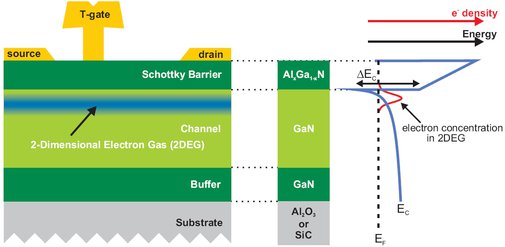Gallium Nitride (GaN) HEMTs
The second species of HEMTs in our group is based on GaN/AlGaN heterojunctions. Instead of using InP substrates the substrates are based on Sapphire (Al2O3) or Silicon Carbide (SiC). These semiconductors are both wide bandgap materials (3.4 eV and 3.3 eV compared to 1.3 eV for InP) and therefore have high electric breakdown fields, which enables applications at high supply voltages. Furthermore, this allows the material to withstand high operating temperatures and provides improved radiation hardness.
To achieve high currents and high frequency operation, high carrier mobilities and high saturation velocities are desirable. Typically, wide band gap semiconductors attain only relatively low mobilities but high saturation velocity values. Compared to the InP-HEMT structure the main differences are:
- No doping in the AlGaN barrier layer is required. Built-in polarisation fields, due to spontaneous polarization and piezo-polarization help to induce the 2DEG.
- Higher 2DEG concentrations are achievable (above 10¹³/cm²) due to the very large conduction band discontinuity.
Applications
The direct bandgap of GaN and its alloys enables the material to be used for both optical and electronic applications. At 300 Kelvin the bandgap of GaN is 3.44 eV, which corresponds to a wavelength in the near ultra violet region of the optical spectrum. This enables the fabrication of high-power optical devices as LEDs and Lasers.
With respect to electronics, GaN is an excellent option for high-power/ high-temperature microwave applications because of its high electric breakdown field and high electron saturation velocity (~1.5 x 10^7 cm/s). The former is a result of the wide bandgap (3.44 eV at room temperature) and enables the application of high supply voltages, which is one of the two requirements for high-power device performance. In addition, the wide bandgap allows the material to withstand high operating temperatures (300°C - 500°C) enabling applications in many commercial areas not covered by other materials.
Given these extraordinary properties typical applications are:
- Wireless Base Stations: Radio Frequency (RF) PowerTransistors
- High-Voltage Electronics: PowerTransmission Lines
- Wireless BroadbandAccess: High-Frequency PowerMMICs
- Mixed-Signal Integration: PowerConditioning
- Radar/ Communication Links
